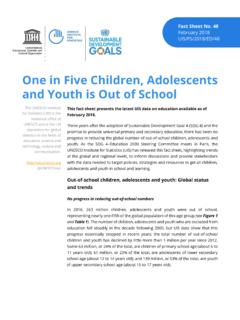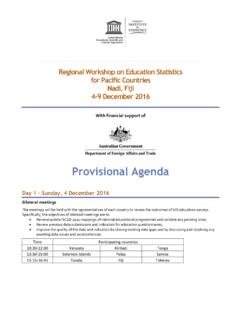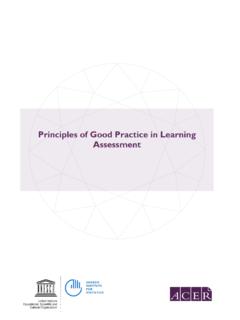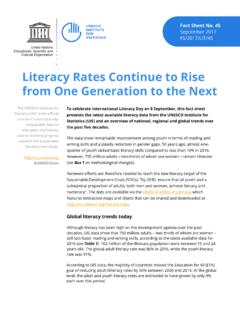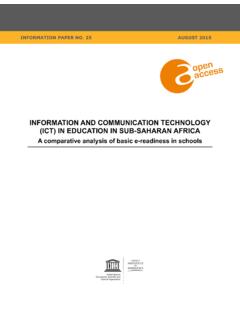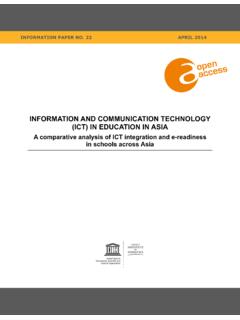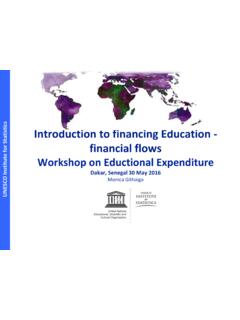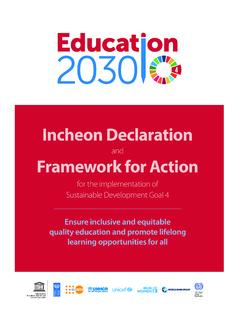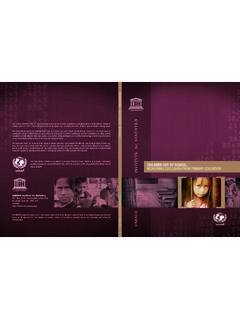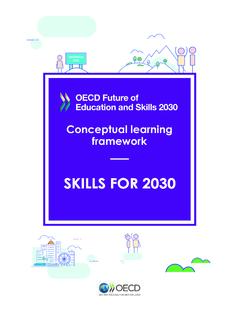Transcription of Quick Guide to Education Indicators for SDG 4 - UNESCO
1 Quick Guide to Education Indicators for SDG 4 Quick Guide to Education Indicators for SDG 4 UNESCOThe constitution of the United Nations Educational, Scientific and Cultural Organization ( UNESCO ) was adopted by 20 countries at the London Conference in November 1945 and entered into effect on 4 November 1946. The Organization currently has 195 Member States and 10 Associate main objective of UNESCO is to contribute to peace and security in the world by promoting collaboration among nations through Education , science, culture and communication in order to foster universal respect for justice, the rule of law, and the human rights and fundamental freedoms that are affirmed for the peoples of the world, without distinction of race, sex, language or religion, by the Charter of the United fulfil its mandate, UNESCO performs five principal functions.
2 1) prospective studies on Education , science, culture and communication for tomorrow s world; 2) the advancement, transfer and sharing of knowledge through research, training and teaching activities; 3) standard-setting actions for the preparation and adoption of internal instruments and statutory recommendations; 4) expertise through technical cooperation to Member States for their development policies and projects; and 5) the exchange of specialized Institute for StatisticsThe UNESCO Institute for Statistics (UIS) is the statistical office of UNESCO and is the UN depository for global statistics in the fields of Education , science, technology and innovation, culture and UIS was established in 1999.
3 It was created to improve UNESCO s statistical programme and to develop and deliver the timely, accurate and policy-relevant statistics needed in today s increasingly complex and rapidly changing social, political and economic in 2018 by: UNESCO Institute for Box 6128, Succursale Centre-VilleMontreal, Quebec H3C 3J7 CanadaTel: +1 514-343-6880 Email: UIS/2018/ED/TD/4 UNESCO -UIS 2018 This publication is available in Open Access under the Attribution-ShareAlike IGO (CC-BY-SA IGO) license ( ). By using the content of this publication, the users accept to be bound by the terms of use of the UNESCO Open Access Repository ( ).
4 The designations employed and the presentation of material throughout this publication do not imply the expression of any opinion whatsoever on the part of UNESCO concerning the legal status of any country, territory, city or area or of its authorities or concerning the delimitation of its frontiers or ideas and opinions expressed in this publication are those of the authors; they are not necessarily those of UNESCO and do not commit the Institute for Statistics | Quick Guide to Education Indicators for SDG 4 3 What is this Guide ?This Guide serves as a Quick reference on how to monitor progress towards Sustainable Development Goal 4 (SDG 4) on quality Education .
5 It provides basic explanations of SDG 4 targets, their Indicators , how they are created and where to find the information needed for these of contents1. What is SDG 4? ..72. What tools exist to measure progress towards SDG 4? ..113. What is the UIS role in SDG 4 monitoring? ..174. How are SDG 4 Indicators developed and calculated? .. Free, equitable and quality primary and secondary Education .. Quality early childhood development, care and pre-primary Education .. Quality TVET and tertiary Education .. Technical and vocational skills.
6 Equal access to all levels of Education and training for the vulnerable .. Youth and adult literacy and numeracy .. Knowledge and skills needed to promote sustainable development .. School environment .. Scholarships .. Qualified teachers ..40 Annex. Targets and Indicators of Sustainable Development Goal 4 on Education ..41 References ..444 UNESCO Institute for Statistics | Quick Guide to Education Indicators for SDG 4 AcronymsAES Adult Education SurveyCLA Catalogue of Learning AssessmentsCONFEMEN Conf rence des ministres de l ducation des tats et gouvernements de la FrancophonieDAC Development Assistance CommitteeDHS Demographic and Health SurveyECLAC UN Economic Commission for Latin America and the CaribbeanECDI Early Childhood Development IndexEFA Education for AllEMIS Education Management Information SystemESD Education for sustainable developmentGAML Global
7 Alliance to Monitor LearningGCED Global citizenship educationGEMR Global Education Monitoring ReportGPE Global Partnership for EducationGPI Gender parity indexHLPF UN High-Level Political Forum on Sustainable DevelopmentIAEG-SDGs Inter-Agency and Expert Group on SDG IndicatorsIAG-EII Inter-Agency Group on Education Inequality IndicatorsICT Information and communication technologyIEA International Association for the Evaluation of Educational AchievementIIEP UNESCO International Institute for Educational PlanningIPUMS Integrated Public Use Microdata SeriesISCED International Standard Classification of EducationITU International Telecommunications UnionLaNA Literacy and Numeracy AssessmentLAMP Literacy Assessment and Monitoring ProgrammeLLECE Latin American Laboratory for Assessment of the Quality of EducationMDG Millennium Development GoalMELQO Measuring Early Learning Quality and OutcomesMICS Multiple indicator Cluster SurveyMPL Minimum proficiency levelNEA National Education AccountNEQMAP Network on Education Quality Monitoring in the Asia-PacificNGO Non-governmental organizationODA Official
8 Development assistanceOECD Organisation for Economic Co-operation and DevelopmentOOSCI UIS/UNICEF Global Initiative on Out-of-School ChildrenPASEC Programme d Analyse des Syst mes ducatifs de la CONFEMEN (CONFEMEN Programme for the Analysis of Education Systems)PIAAC Programme for the International Assessment of Adult CompetenciesUNESCO Institute for Statistics | Quick Guide to Education Indicators for SDG 4 5 PILNA Pacific Islands Literacy and Numeracy AssessmentPIRLS Progress in International Reading Literacy StudyPISA Programme for International Student AssessmentPRIDI Programa Regional de Indicadores de Desarrollo InfantilSACMEQ Southern and Eastern Africa Consortium for Monitoring Educational QualitySDG Sustainable Development GoalSEAMEO Southeast Asian Ministers of Education OrganizationSEA-PLM Southeast Asia
9 Primary Learning MetricsSLS Short Literacy SurveySTEP Skills Towards Employment and PorductivitySWTS School-to-Work Transition SurveyTCG Technical Cooperation Group on the Indicators for SDG 4- Education 2030 TERCE Tercer Estudio Regional Comparativo y Explicativo (Third Regional Comparative and Explanatory Study)TIMSS Trends in International Mathematics and Science StudyTVET Technical and vocational Education and trainingUIS UNESCO Institute for StatisticsUNESCO United Nations Educational, Scientific and Cultural OrganizationUNICEF United Nations Children s FundUNSD United Nations Statistics DivisionUNESCO Institute for Statistics | Quick Guide to Education Indicators for SDG 4 71.
10 What is SDG 4? Heads of State, government leaders, UN high-level representatives and civil society met in 2015 at the 70th Session of the United Nations General Assembly and adopted the 2030 Agenda for Sustainable Development. This ambitious agenda, of the people, by the people, and for the people, was designed with the active involvement of UNESCO . Education plays a central theme throughout the 2030 Agenda, which includes a stand-alone Education goal and Education -related targets within 7 other of the 17 Sustainable Development Goals (SDGs).
